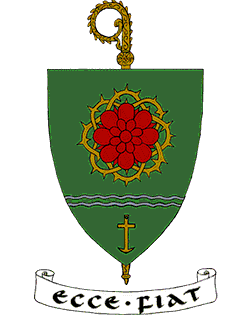Vestimentum tuum candidum quasi nix…Thy garments are white as snow, and thy face is as the sun. (2nd Antiphon of Laudes).
Dear Brothers and Sisters in Christ,
My Very Dear Sons,
In contemplating the spectacle of the Immaculate Conception, such is the spiritual splendor and brightness of the vision, supposing we turn our soul toward this mystery with humility, such is the power of Mary’s immaculate radiance, that one might fear going “snow blind” so to speak, of being blinded for shear excess of light. It is tempting for one who preaches to conclude (hastily) that there is nothing to say about such uniform whiteness, nothing to comment upon here, whereas in truth such beauty rightly considered, could feed our contemplation for year upon year, age upon age. Our Lady’s light is not the light of divinity, the brightness we could not contemplate on earth and live. Rather it is a marvelously adapted radiance that allows us to see something of God’s own luminosity precisely without causing us to lose our sight. It is an immaculate mercy and divinely ordained condescendence proportioned to the weak mortals that we are. It brings not blindness but kindness.
“Hail, full of grace,” exclaimed the Archangel, coming before the Mother-of-God-to-be, “the Lord is with thee. Blessed art thou among women.” (Lk. 1:28) The vocation of the Virgin of Nazareth is utterly unique, her grace is not shared by other women. She belongs in a category of one. And yet she remains approachable; she is a mother—our mother too.
Some moderns, wanting to avoid the possible pitfall of excessive devotion, have tried to make Our Lady seem just like any other woman, pulling her “down from her pedestal” and creating for her a less exalted persona. It is true that this woman, the real Mary, is utterly humble and close to us, but this modern approach can cause us to lose from sight the supernatural beauty that God has given her for the benefit of the Church and for all mankind. As with the holy liturgy and other aspects of the life of the Church, there has often been a kind of “trivialization” of the Blessed Virgin that misses the point. But some just cannot see the forest for the trees and cannot see the Saint for the halo.
What we must agree upon is that God, and only God, in His infinite wisdom, could have joined these seeming opposites: on the one hand, the exalted vocation of a unique woman, the New Eve, and, on the other, the consoling humility of the “handmaid of the Lord,” who, unlike earthly queens, is very close to her subjects, who are her children. This is really just a reflection of what God did in the Incarnation itself, joining the Godhead to human nature, so as to send us the Emmanuel, “God with us.” Even an ancient pagan author perceived something of this from afar.
Valet ima summis mutare, et insignem attenuat Deus, obscura promens. God can change the lowest into the highest, can extinguish the proud, and bring the obscure into prominence. (Horace, Odes, I, 34)
If Our Lady’s whole being is this beautiful brightness, what of her Heart? The heart in biblical terms is not just the organ that distributes blood to the body, but is seen as the seat of the soul and of the mind. The Immaculate Heart thus represents the inner most region, the inner most reality of the Immaculate Mother of God. Over the last century the Church has come to understand much more about the role that Our Lady is called upon to play in the history of mankind through the revelation at Fatima of the mystery of the Immaculate Heart. It seems we are living in apocalyptic times, even if no one can say when the end of the visible world might take place. The fact that God would provide for a special call to devotion to the Immaculate Heart certainly indicates an unusually difficult period of History and the need of our time for special aid. The devotion to the Immaculate Heart is a development of the great mystery of the Immaculate Conception, believed by the Church for centuries, but only defined in the nineteenth century by Blessed Pope Pius IX.
Saint Louis de Montfort, that great Marian saint, spoke of the “Apostles of the last times or “end times” with great force:
Toward the End of Time, he writes, God will raise up great men full of the Holy Spirit and imbued with the spirit of Mary, through whom this powerful Sovereign will work great wonders in the world, so as to destroy sin and to establish the Kingdom of Jesus Christ, her Son, upon the ruins of the kingdom of this corrupt world. (Secret of Mary, 59)
Now is perhaps that time, when the good must trust in the “spirit of Mary” as Saint Louis says and in her Immaculate Heart in order to bear witness to Christ in a society grown cold to the Gospel. Perhaps the immaculate and snow-like whiteness of Mary will blind the enemies of the Church and, hopefully, bring their pride down to the ground, like that of Saint Paul, so that they may be converted and saved from the destruction to come.
O Mary conceived without sin, pray for us who have recourse to thee. Our Lady of Guadalupe, Our Lady of the Snows, Pray for us. Amen.



